Written by Joel T. Lewis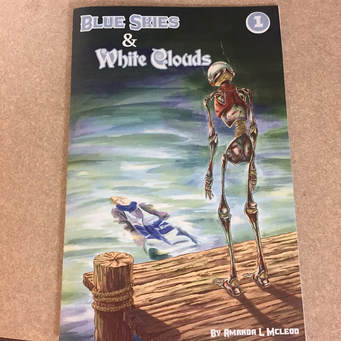 Amanda McLeod was the very first comic book artist that I ever got to talk to face to face. Walking the floor of Artist Valley at Denver Comic Con in 2015 I kept circling back to a particular booth with a sketch that I couldn’t get out of my head. It was an eerie, reed-like, and skeletal robot creature like nothing I’d ever seen before. Watching my bank account trend all too quickly toward zero throughout the weekend, I finally drummed up the courage to step up to her booth and ask about the character. I was nervous. New to the 3-day experience at Denver Comic Con and having never talked directly to a comic book artist before, I wasn’t sure whether I would get a sales pitch or a moody creative who would brush off my inquiry. I got neither. McLeod was an excited and earnest creator who was so happy to have somebody to talk to about her work! This experience, this instant link through excitement and creativity was the perfect snapshot of what Comic Con is about. Nerds excited to meet Nerds who create Nerd things and Nerds who’re excited to share the Nerd things they’ve made. I got my very first commissioned sketch and my first self-published comic book ever from Amanda. The following year I scoured the booths in Artist’s Alley searching for issue 2 of Blue Skies and White Clouds but to my sorrow it hadn’t been produced yet. Having given up hope for issue 2 in 2017, imagine my surprise as I caught sight of the same fascinating character that stuck in my mind two years ago. I stopped dead, whirled towards the booth, and got to catch up with Amanda. Having taken a year off to complete her Master’s Thesis, Amanda was back with issue 2 hot off the presses and was as earnest and excited by my fan-boying as she was the first time. I was far less tentative as I spoke to her this year, as my surprise and excitement bubbled up by the sight of the 2nd issue. Amanda is an exceptional artist and an ambitious writer whose first two issues set up a narrative filled with mystery, technology, and magic. We follow the misadventures of Amy, Mariano, and the Azure Thief (the skeletal robot) in a tale of curiosity, identity, and secrecy. Amy and Mariano bring to life the junkyard robot they’ve been fiddling with and adventure ensues as the Thief tries to reconcile memories with reality while avoiding discovery and capture. I don’t want to give away anymore of the plot than that because both issues of Blue Skies and White Clouds are available online and I’d love you to be able to discover for yourself the talent of an artist who made Denver Comic Con special for me. The first two issues of Blue Skies and White Clouds are available online at http://blueskiesandwhiteclouds.smackjeeves.com/
0 Comments
Written by Zeke Perez Jr.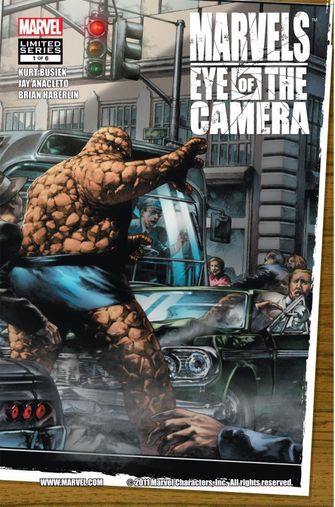 What would it be like to live in a world with superheroes? When we watch superhero movies or read comic books, we’re transported into such a world. But what if you woke up tomorrow and that world came to you? What if you looked out your window only to see a man in a blue spandex suit stretch his limbs or a flaming human figure flying through the sky? What if superhumans, mutants, monsters, and other creatures were all a part of everyday life, battling it out in your hometown? Plenty of recent movies and shows from both Marvel and DC focus in on the impact that heroes would have on the average people around them. In Spider-Man: Homecoming, the central villain is directly motivated by the destruction that heroes were responsible for in the Battle of New York. Students at the Midtown School of Science and Technology learn about the Sokovia Accords in history class and gossip about the Avengers. In Luke Cage, a street side bootlegger sells videos of ‘The Incident’. In Batman v. Superman: Dawn of Justice, the latter is brought to court to account for the destruction of Metropolis brought about by his battle with General Zod. He becomes a controversial figure as people are torn between supporting him and heroes like him for the good they do or condemning them for their unchecked powers and the havoc they wreak. The theme of the conflicted citizen is a very valid one. Superhero movies or comics have often overlooked the impact that superheroes have on the cities they fight to save. The plot implications of buildings being leveled and lives ruined are ignored for the sake of big special effects budgets. But in Captain America: Civil War and the movies mentioned earlier, citizens living amongst superheroes has become a key plot point. That makes for a perfect time to read or re-read Marvel’s Marvels: Eye of the Camera. Marvels: Eye of the Camera is a sequel to the original Marvels, a four-issue comic series written by Kurt Busiek and released in 1994. Marvels examined the Marvel Universe through the eyes of everyman photographer Phil Sheldon. Marvels: Eye of the Camera followed up 15 years later with a six-issue series reprising the characters and the format. Sheldon struggles with his legacy and worries that the public views heroes as ‘sideshow freaks’ because of how his work was framed. He rejects his publisher’s idea of releasing a book about super villains, hoping to avoid increasing fear in the community. 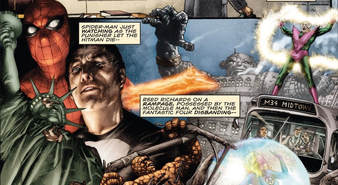 Citizens are coming to terms with their feelings about mutants, taking positive and negative stances on the matter, often revealed through ‘man on the street’ style interviews. The language used in Eye of the Camera fosters the sense of mystery that comes with being an onlooker in a superheroic world. Rumors of ‘a monster in the southwest’ send photographers ‘to New Mexico to try to get pictures of this hulk out there’. Other characters are revealed in a similar fashion. In the Eye of the Camera universe, reports on heroes or mutants are everyday news. They even become so frequent that viewers lose interest and the reports eventually turn into mundane celebrity gossip (along the lines of, ‘who is Invisible Girl dating now?!’). Heroes are almost a nationwide spectacle, with The Thing appearing at Muscle Beach to promote a Fantastic Four movie or with the Avengers hosting open tryouts at Yankee Stadium. Sheldon is conflicted about this and the role of the media, asking ‘Did we corrupt them, drag them down to our level?’ The series should excite any Marvel fan, as it boasts an unbelievably long roster of Marvel heroes either making an appearance or being referenced. Another truly outstanding aspect of the series is that it almost acts as a historical fiction book. Every picture or storyline of a superhero in the comics is taken from its original comic appearance, complete with a reference table in the back of the trade paperback identifying which series and issue they came from. We have long imagined what being in a world with superheroes would be like. This series shifts the thought to what would it be like if they were in ours? With a lot of comic media tackling this theme, now is the perfect time to revisit the masterpiece that is Marvels: Eye of the Camera. Written by Joel T. Lewis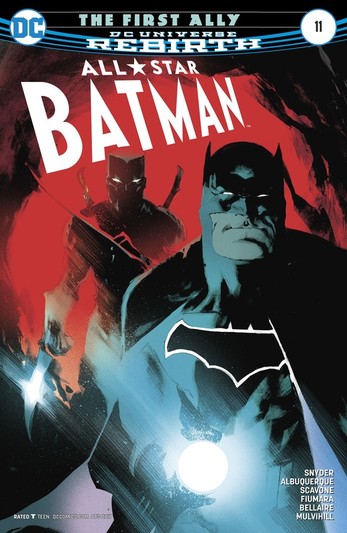 In issue 11 of All-Star Batman Scott Snyder takes us through an accelerated character history of Alfred Pennyworth that focuses on the impact of his absentee father. Unlike his adopted son, Alfred’s father was never around because of his dedication to serving the Wayne family an ocean apart from Alfred and his mother. In recounting his history, Alfred reveals that his origin, much like Bruce’s, began with anger and rebellion which was not curbed by the influence of a father figure. Leading off where the graffiti chase ended in the last issue, Snyder continues his characterization of young Alfred as a punk rock youth struggling to define himself in a fatherless home and ultimately coping with the death of his mother alone. This cruel negligence is lightened a bit by Rafael Albuquerque’s rendition of Alfred as a mohawked youth with multiple ear piercings. This punk origin gives us the vaguest sense of why Alfred has gone along with Bruce’s vigilante crusade for so long: it's a righteous inversion of the status quo and that is so punk rock. Batman operates outside the established order, with an admittedly rigid loyalty to American justice, but nonetheless the boldness of Batman’s stand against the corruption of the establishment speaks to a youthful rebellion that lives in Alfred still. After narrowly escaping an alligator-induced death thanks to a last-minute assist from the Black and Whites (Penguin, Black Mask, and Great White Shark) Batman discovers that the Genesis Engine he’s been tracking down is a device that can rewrite cellular biology, giving anyone with access to it the ability to create genetically designed monsters. Surprisingly, the Black and Whites are interested in the device because they want it destroyed and they saved Batman to help them. Batman's search for the Genesis Engine and Thatch’s mysterious murderer leads him to the massive Submarine Casino known as the Flying Dutchman operated by the Gangster, Tiger Shark. Finding himself once again a step behind, Batman arrives on the Dutchmen to discover the dual-bladed murderer of Thatch has killed the thugs onboard the submarine and already has the Genesis Engine. Batman himself is quickly dispatched as the villain, whose outfit closely resembles a medieval knight’s armor, slashes at both Batman and the glass interior of the sub, crippling both as Batman fights for consciousness and the sub begins to sink. The caped crusader’s peril is punctuated by flashbacks showing Alfred’s dissatisfaction with his decorated career in the SAS and his recruitment by a mysterious MI-5 operative named Briar. As the issue concludes it appears that Briar, who we discover to be the architect of the trap laid for Batman, threatened Alfred’s life in the past and it appears that both Pennyworth and Batman were unable to escape the violent machinations of this operative. One of the strengths of the All-Star Batman series has been how confidently and cleverly Snyder separates Batman from Gotham City, and this most recent arc has been no exception. Batman in Miami and Batman under the sea seem like very uncharacteristic combinations for the street-level vigilante however, the flair with which Snyder weaves in pirate lore into these settings suits the Bat really well. This fish-out-of-water setting (pun-intended) is reminiscent of the 90’s era of Batman action figures whose suits and gadgets corresponded to countless settings and scenarios. Snyder’s interpretation of Deep-Sea Batman is pure fun and manages to tell a compelling present and past story without getting too dark and gruesome. Artist Rafael Albuquerque returns and skillfully executes Batman and Alfred in both sunshine and shade amidst explosions and crocodiles. A particular favorite panel of mine depicts Alfred soaring over the open sea in a bat-shaped glider as Bruce is seconds away from an underwater oblivion. With only 3 issues remaining as All-Star Batman will be the first casualty among the Rebirth titles, Snyder’s 'First Ally' arc continues to fascinate and deliver the fun and dexterity of the caped crusader and one of his most talented chroniclers. Until next time, Geek On! Written by Joel T. Lewis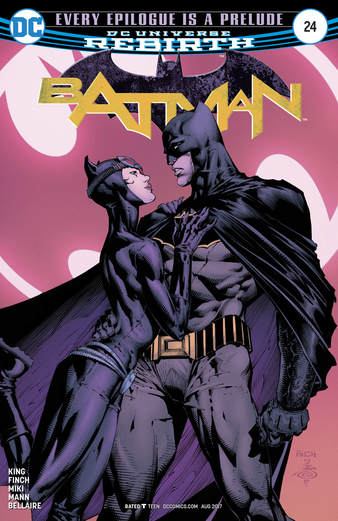 As Batman continues to examine his life and vigilante crusade after his father’s dying plea to find happiness, Tom King’s issue 24 focuses on an extended discussion between the caped crusader and Gotham Girl (Claire Clover). As Gotham Girl debates whether to remain a hero Bruce provides a new intimate perspective on his own fight against crime. Instead of just dictating what Claire ought to do, Bruce confides in her about how Alfred’s protests early on in his career as Batman had no effect on his plan to reshape the Gotham underworld. Batman’s measured compassion with Claire speaks to the impact that Thomas Wayne’s final words have had on the Dark Knight. The control and cold manipulation Batman has employed over the men and women he’s mentored has always created barriers, but this intimate honest discussion shows a dramatic shift in Batman’s mentoring philosophy. Batman is very candid about the nature of the mantle he created, 'I do this. But I’m not...happy...I do this to be happy. I try and I fail.' Claire responds in earnest, 'Why do you fail? Why can’t you be happy?' Batman replies, 'I fail because I’m scared. What I’ve seen. Gotham. Him. If you’re not scared...if all that doesn’t scare me...then I’m insane. And I’m not…I don’t want to be insane. So I’m scared.' Bruce’s vulnerability and self-awareness throughout this issue is poignant and powerful. Interlaced throughout this issue the brilliant David Finch depicts a late night game of Cat and Bat as Batman chases Catwoman over the rooftops of Gotham city. When Batman catches up to her one of the most important moments in Bat history takes place: Bruce Wayne proposes to Selina Kyle. Now this is not truly new territory as Bruce and Selina have been married way back in the Golden Age continuity but this has potential to be a development that sticks. In a sense, the bond between Batman and Catwoman is one fans have championed for nearly as long as Peter Parker’s been with Mary Jane or Clark Kent with Lois Lane, and rather than feeling hackneyed or cheap, Bruce’s proposal at the end of issue 24 feels completely earned. Though their relationship has run the gamut from intimate and tender to estranged and tumultuous, the playful connection between Catwoman and Batman has always felt weighted and genuine which is why this proposal doesn’t seem forced. Their dual lives, their unspoken respect for each other’s skills, and their complementarily damaged psyches have always led them back to each other and now they could be getting married. What does a married Bruce Wayne look like? How do a cat burglar and a superhero build a functional partnership? Where does Batman figure into this attempt at traditional domestic bliss? What does the wedding party look like? Though issue 24 doesn’t move mountains of plot, the questions it raises are fascinating and David Finch’s artwork is breathtaking. The stark contrast between Gotham Girl and Batman’s daylight discussion of heroes and their motivations and the late night scenes of Batman chasing the woman he loves are brought to brilliant life. These images weave their own narrative and were it not for Tom King’s brilliant deconstruction of Batman’s shifting motivations I would have said Finch’s work could have been published without words and the impact of that final page proposal would have been just as poignant. Though the next 8 issues of Batman are set a little over a year after Batman began his one-man war on crime I can’t help hoping that when we return to the present, Tom King treats us to a little more catharsis. I would love to see this vulnerable Bruce talk to Dick Grayson, confide in Alfred, maybe even Commissioner Gordon. It would be such a shame for this drastic re-examination of the purpose of Batman to only impact Gotham Girl and Bruce’s relationship when the most intimate and important members of the Bat-Family, those most affected by the ripples of Batman’s influence, could really grow and benefit from seeing Bruce transition. Tom King is doing a bang-up job with Batman and it is always a pleasure to see David Finch’s work and I cannot wait to see how the rest of the Selina Kyle/Bruce Wayne relationship unfolds and I’m really excited for King’s upcoming arc 'The War of Jokes and Riddles'. Until next time, Geek On! Written by Joel T. Lewis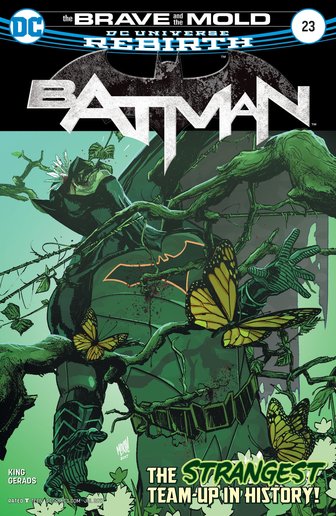 I am rapidly discovering that I should have been following Tom King’s run on Batman a lot earlier. There are 3 things that I love that compelled me to continue reading the Batman series after the conclusion of ‘The Button’, first the name of the issue was ‘The Brave and the Mold’, second the throwback subtitle ‘The Strangest Team-Up in History’ on the cover which harkened back to the playful silliness of older comics, and the fact that Swamp Thing guest stars in this issue. Swampy, puns, and nostalgia are already worth the price of admission, but what I found between the covers of this issue was spectacular. The Batman and Swamp Thing team-up to discover who killed Lloyd Bernard McGinn, the biological father of Alec Holland who became the Swamp Thing. This issue was just a delight, especially for a Swamp Thing fan like me. The first page depicts McGinn’s murder and the man bears more than a passing resemblance to Comic Creator and patron saint of Swamp Thing, Alan Moore. This may be in reference to Moore’s recent retirement from comic bookery which was announced last year, or perhaps it was just meant as a tribute to the man who made Swamp Thing the iconic character he is today, but an easter egg of that magnitude from the very first panel was enough to make me instantly fall in love with this comic. But the hits kept coming as Batman and Swampy have a conversation in the library of Wayne Manor with Alfred rushing around to clean up after the Swamp Creature, they good-cop/bad-cop the villain Kite-Man (which is a level of silly I never expected from modern DC), and trade comedic pauses in the Batcave and Batmobile. For some reason the brilliance of pairing Batman and Swamp Thing up had never occurred to me before, but for two characters defined by such unique stoic philosophies to work together makes for some unexpected humor and camaraderie that was really entertaining. But this issue really shines through its artwork and its exploration of fatherhood and loss. Coming off the poignant conclusion of ‘The Button’ storyline Batman’s determination to uncover who murdered Alec Holland’s father carries a greater weight as he admires Swamp Thing’s projected acceptance of the circular nature of life and death. Reliving the grief that made him Batman Bruce is almost relieved to see that Swamp Thing (a mysterious stoic much like himself) is handling the loss so well. Batman seems grateful and encouraged by the distraction of a new case and Swamp Thing’s philosophical explanation of life’s transition from state to state comforts him more than he lets on. That is until the final pages where Batman and Swamp Thing confront McGinn’s murderer, a mohawked villain called Headhunter. Swamp Thing’s measured posture melts away in this final confrontation and he consumes Headhunter in a mournful rage born out of regret and pain that he had kept well-hidden underneath his mossy exterior. Batman is devastated and calls out in confusion as Swamp Thing sends root, branch, and bloom through Headhunter’s insides. Batman’s sense of betrayal is twofold here: first Swamp Thing used him to get close to his father’s killer and second, Swamp Thing’s inability to cope with the grief means that the circular philosophy of life and death that he spoke of before wasn't true. Bruce was holding onto that green world logic to protect him from the pain of losing his father a second time and without that he collapses under his grief and anger. This poignant issue is brought to dazzling life by artist Mitch Gerads whose take on Swamp Thing is one of my favorites. The intricate detail and beauty through mulch that Gerads achieves is sensational. One of my favorite touches is that while Bruce and Swamp Thing talk in the library of Wayne Manor, Swamp Thing sprouts a delicate vegetable tea cup out of his hand and sips from tea he produces out of thin air. This and the gruesome beauty of his killing of Headhunter make this issue a must have for fans of Swamp Thing artwork. As Bruce continues to cope with the last words of Thomas Wayne after seeing the pain Swamp Thing goes through one can't help but wonder if the caped crusader can continue his one-man war on crime as before. Batman has come to a crossroads and I cannot wait to see what Tom King has in store for him next! Until next time, Geek On! |
Archives
May 2024
|
|
© 2012-2025, Nerds That Geek LLC.
All Rights Reserved. |
uWeb Hosting by FatCow
